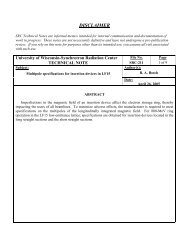SRC Users' Meeting - Synchrotron Radiation Center - University of ...
SRC Users' Meeting - Synchrotron Radiation Center - University of ...
SRC Users' Meeting - Synchrotron Radiation Center - University of ...
Create successful ePaper yourself
Turn your PDF publications into a flip-book with our unique Google optimized e-Paper software.
THE P(1s) AND P(2p) XAFS SPECTRA OF ELEMENTAL<br />
PHOSPHORUS, THEORY AND EXPERIMENT<br />
Astrid Jürgensen<br />
Canadian <strong>Synchrotron</strong> <strong>Radiation</strong> Facility, <strong>Synchrotron</strong> <strong>Radiation</strong> <strong>Center</strong>,<br />
3731 Schneider Drive, Stoughton, WI, USA 53589-3097<br />
X-ray absorption spectroscopy was used to study the local structure and chemical bonding <strong>of</strong><br />
elemental phosphorus. Three allotropes <strong>of</strong> this element exist in the solid state. Crystalline black-<br />
P, a semiconducting material with an orthorhombic puckered layer structure, is the most stable<br />
allotrope. White-P, the least stable allotrope, is composed <strong>of</strong> tetrahedral P 4 molecules. At room<br />
temperature it is a plastic crystal. Its structure is similar to -Mn with the P 4 molecules in the<br />
positions <strong>of</strong> the Mn atoms. The most common allotrope is the amorphous red-P. Like white-P it<br />
is composed <strong>of</strong> P 4 molecules. In the gas phase tetrahedral P 4 molecules are stable up to ~ 800 ºC.<br />
At higher temperatures they decompose into P 2 molecules that have a shorter P-P bond length<br />
and, like N 2 , a formal triple bond.<br />
Theoretical P(1s) and P(2p) XAFS spectra <strong>of</strong> gaseous and solid state phosphorus were<br />
calculated by ab initio FEFF and GSCF3 methods. These were compared and the spectral<br />
features were related to structural and electronic properties <strong>of</strong> the different allotropes <strong>of</strong><br />
elemental phosphorus. The calculation results were then used to explain the features observed in<br />
the experimental P(1s) and P(2p) spectra <strong>of</strong> red-P, which were obtained at the DCM and<br />
Grasshopper beamlines <strong>of</strong> CSRF, respectively. They were measured simultaneously by total<br />
electron yield (TEY) and fluorescence yield (FY) with the incident photon beam at normal<br />
incidence to the sample surface.<br />
The results <strong>of</strong> this study were presented at the XAFS 12 conference, held in Malmö, Sweden in<br />
June <strong>of</strong> 2003. A paper has been submitted to Physica Scripta to be published in the conference<br />
proceedings. A temperature dependent P(1s) EXAFS study <strong>of</strong> red-P is in progress to determine<br />
the Debye-Waller factor (the mean square deviation <strong>of</strong> the interatomic distance) <strong>of</strong> the first<br />
coordination shell in red-P.<br />
0.1<br />
0.05<br />
0<br />
-0.05<br />
-0.1<br />
3 6 9 12 15<br />
P4 molecule<br />
theory<br />
0 1 2 3 4 5 6<br />
0.35<br />
P4 molecule<br />
0.28<br />
theory<br />
0.21<br />
0.14<br />
0.07<br />
(k)<br />
0.1<br />
0.05<br />
0<br />
-0.05<br />
-0.1<br />
0.1<br />
0.05<br />
0<br />
-0.05<br />
-0.1<br />
white-P<br />
theory<br />
black-P<br />
theory<br />
FT(k 3 (k)) (Å -4 )<br />
0<br />
0.28<br />
0.21<br />
0.14<br />
0.07<br />
0<br />
0.28<br />
0.21<br />
0.14<br />
0.07<br />
white-P<br />
theory<br />
black-P<br />
theory<br />
0.1<br />
0.05<br />
0<br />
-0.05<br />
red-P<br />
experiment<br />
0<br />
0.12<br />
0.09<br />
0.06<br />
red-P<br />
experiment<br />
-0.1<br />
0.03<br />
3 6 9 12 15<br />
k (Å -1 )<br />
0<br />
0 1 2 3 4 5 6<br />
R (Å)<br />
The experimental P(1s) (top) and P(2p)<br />
(bottom) XANES spectra <strong>of</strong> red-P<br />
The P(1s) EXAFS spectrum (left) and its Fourier Transform (right). The first<br />
peak in the FT represents the first coordination shell with an interatomic<br />
distance <strong>of</strong> 2.212 Å.
















